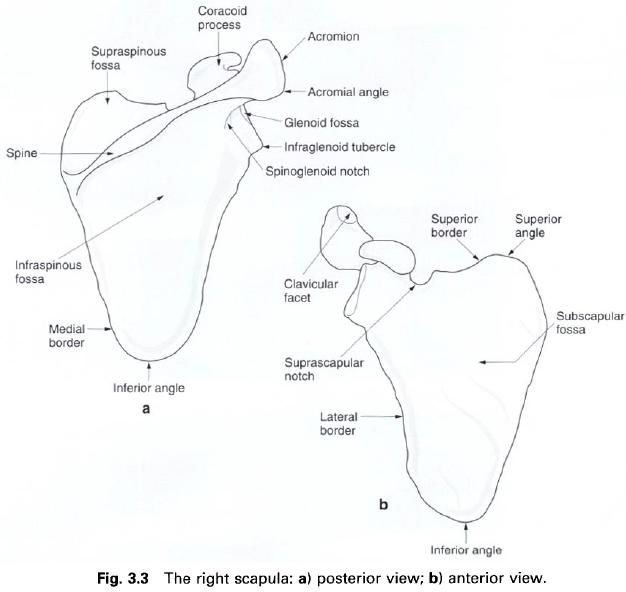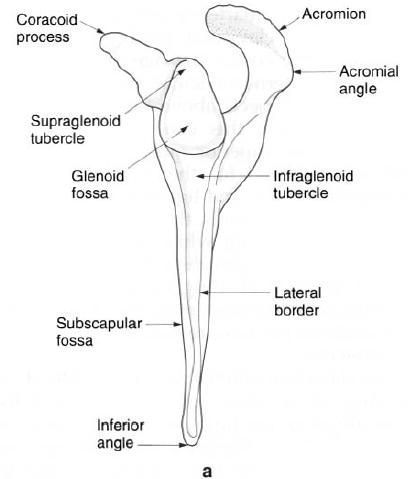The scapula is a large, flat, triangular plate
of bone on the posterolateral aspect of the thorax, overlapping the second to
the seventh ribs. Suspensed in muscles, the scapula is held in its lateral
position by the strutlike clavicle, but has great mobility relative to the
thorax. As it is a triangular bone it presents three angles, three borders and
two surfaces which support three bony processes.
Left
scapula, lateral view
The costal surface which faces the ribs is
slightly hollowed and ridged with a smooth, narrow strip along its entire
medial border. It is also known as the subscapular
fossa.
The dorsal surface faces posterolaterally and
is divided by the spine of the scapula into a smaller supraspinous fossa above and a larger infraspinus fossa below. The supraspinous and infraspinous fossae
communicate via the spinoglenoid notch between the lateral end of the spine and
the neck of the scapula. The spine of the scapula has upper and lower free
borders which diverge laterally enclosing the acromion.
The thin medial
border ascends from the inferior to the superior angle, being slightly
angled at the medial end of the spine. The lateral
border is thicker, being deeply invested in muscles, and runs down from the
infraglenoid tubercle below the glenoid fossa to meet the medial border
at the inferior angle. The superior border, which is thin and
sharp, is the shortest of the three, and has the suprascapular notch marking the junction with the root of the
coracoid process.
Inferiorly, the thick inferior angle lies over the seventh rib and is easily palpated.
The superior angle lies at the
junction of the medial and superior borders, whilst the lateral angle is truncated and broadened to support the head and
glenoid fossa of the scapula.
The head of the scapula is an expanded part of
the bone joined to a flat blade by a short inconspicuous neck. The glenoid fossa(or cavity) is found on the
head as a shallow, pear-shaped concavity, facing anterolaterally. The glenoid
fossa is broader below and articulates with the head of the humerus thereby
forming the shoulder joint. Immediately above the glenoid fossa is the supraglenoid tubercle, which gives
attachment to the biceps brachii.
The acromion
process, which is the expanded lateral end of the spine, is large and
quadrilateral, projecting forwards at right angles to the spine. The lower
border of the crest of th spine continues as the lateral border of the acromion, the junction of these two
borders forming the palpable acromial angle. The upper border of the crest
becomes continuous with the medial border of the acromion and presents an oval
facet for articulation with the clavicle at the acromioclavicular joint. The
superior surface of the acromion is flattened and subcutaneous.
The coracoid
process is a hook-like projection with a broad base directed upwards and
forwards from the upper part of the head, and a narrow more horizontal part
which passes anterolaterally from the upper edge of the base. The tip lies
below the junction of the middle and lateral thirds of the clavicle.
Palpation
Starting at the lowest point, the inferior
angle can readily be gripped between thumb and index finger and, if the subject
relaxes sufficiently, can be lifted away from the thorax. The medial border can
be followed along its whole length from inferior to superior angles. The spine
of the scapula can be palpated as a small spine of the scapula can be palpated
as a small triangular area medially and increases in size as the fingers are
moved laterally along it. The flat crest with its upper and lower borders can
be identified. Continuing along the lower border of the creast to its most
lateral point, the sharp 90° acromial angle can be felt. This continues as the
palpable lateral border of the acromion. Running onto this lateral border the
flat upper surface of the acromion can be felt above the shoulder joint. The
coracoid process can be palpated as an anterior projection below the lateral
part of the clavicle, and therefore is a useful reference point for surface marking
the shoulder joint as it lies just medial to the joint line.
Ossification
The scapula ossifies from a considerable number
of centres. The primary ossification centre appears in the region of the neck
by the eighth week in utero, so that at birth the coracoid process, acromion,
glenoid cavity, medial border and inferior angle are still cartilaginous.
Secondary centres appear in each of these regions except the coracoid between
the ages of 12 and 14 years, fusing with the body between 20 and 25. The secondary
centre for the coracoid process, however, appears during the first year and
fuses with the body between 12 and 14 years.











0 коментара:
Постави коментар